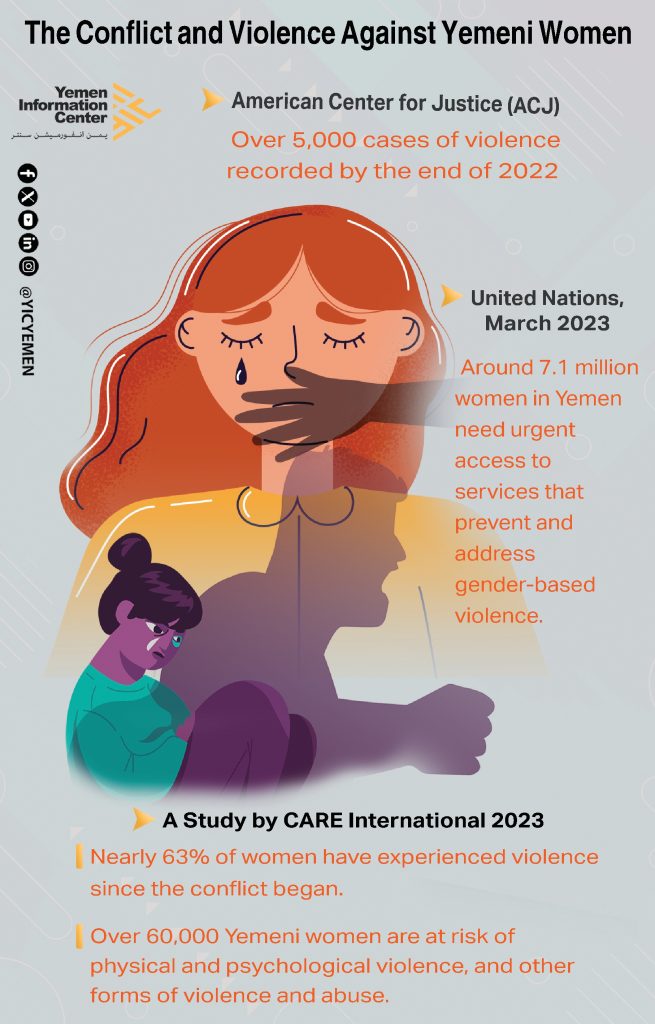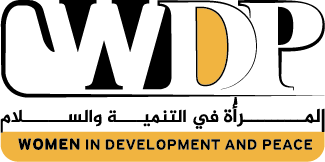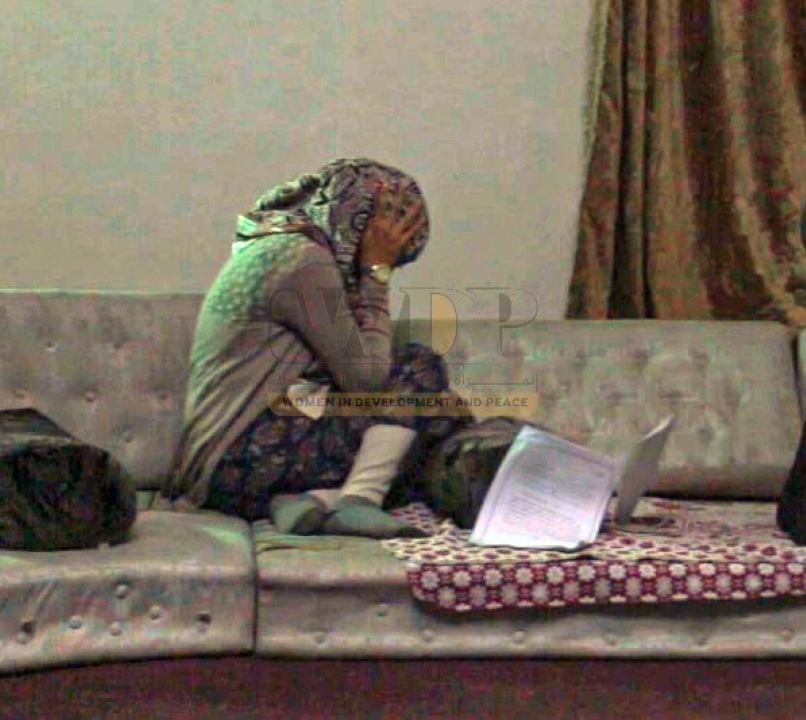Women in Development and Peace – Hanan Hussein
The conflict in Yemen is one of the most complex conflicts in the world; it has worsened all forms of discrimination against Yemeni women, and women in Yemen are facing harsh conditions that directly threaten their lives and basic human rights.
Um Ali (prefers not to mention her name) lives in a rural area near Sana’a, with her two children and mother after her husband’s death, the family’s sole breadwinner.
Um Ali passionately says, “I travel a long distance to work in a house to provide a living for my family after the salary that used to meet my children’s and mother’s needs stopped.” She adds, “The conflict has only brought negativity into our lives; we only knew need during the armed conflict that forced us to go to the village and temporarily stay in our old house, where we faced hunger, prompting us to choose to return to the city and confront the challenges by looking for work to support them.”
“My children are still below school age, but my mother needs regular treatment. The matter is the biggest challenge I face, as it makes me continue working despite all the circumstances”… These words flow from her with tears streaming down her cheeks.
Um Ali is just one example of many Yemeni women who stood alone in the face of armed conflict, as a shield to protect themselves and those around them, and as models of dedication, sacrifice, and altruism, in addition to strength and resilience despite the fragility of their souls in the face of this dangerous and destructive scourge.
Statistics
The United Nations organization said in one of its publications in 2023: Yemen is going through one of the most humanitarian crises around the world; millions of Yemenis need some form of assistance. According to a statement by a representative of the United Nations Population Fund in Yemen, Nestor Owomuhangi, published on Facebook, “Women and children make up nearly 76% of the displaced in Yemen, and amid all the difficulties, women have remained strong and flexible in most cases, and they are the ones who bear the burden of supporting their families.”
The United Nations Population Fund also indicates that in Sana’a, Aden, and Hajja, there are nearly 800,000 displaced persons who are women and girls aged between 15 and 49 years old, and according to the report, they are at risk of gender-based violence. Women in Yemen are the primary breadwinners for a third of the families who have been displaced from their homes and areas due to the conflict. The United Nations Population Fund published a report entitled “The Spread of Violence against Women and Girls Amid Ongoing Conflict in Yemen” in March 2023, stating that women and children make up three-quarters of the total 4.5 million displaced persons in Yemen. Women support approximately 26% of displaced families, yet discriminatory practices against women continue to hinder women’s ability to support themselves and their families. The system prohibits working women in the humanitarian field from providing necessary support and assistance.
The report also stated that approximately 12.6 million women in Yemen need life-saving services in reproductive health and protection, and about 7.1 million women in Yemen need urgent access to services that prevent or treat gender-based violence, yet these services remain extremely limited or completely absent in some areas.
A statement released by the American Center for Justice (ACJ) coinciding with the 16 Days of Activism against Gender-Based Violence, revealed alarming statistics showing an increase in violence against women by conflict parties in Yemen during the years of war. Over 5,000 cases of violence were recorded by the end of 2022.
A 2023 study by CARE International revealed that the percentage of women facing violence in Yemen is increasing day by day. Since the start of the conflict, the number has reached nearly 63%, and over 60,000 Yemeni women are at risk of physical, psychological, and other forms of violence and abuse.
Increasing Rates of Violence
Nada Al-Soumali, a social specialist, talks about the reasons for violence by saying: “Violence rates are high during and before the conflict, but it expanded during the conflict for many reasons; including poverty, low living standards, unemployment, lack of awareness, low education rates, gender discrimination, armed conflicts, and the occurrence of a climate of disputes and tension that greatly incites violence.”
Nada adds, “Cultural, educational, and social differences between spouses can create a deep gap that leads to clashes, arguments, and violence by one against the other.”
Jamala Al-Qadhi, from Women’s Union in Yemen, believes that the increase in the rate of disputes is due to the economic weakness of the head of the family. However, almost 85% do not physically harm their wives; because the Yemeni woman is honored in her home by her husband and family, and very few lay a hand on her; for specific reasons, such as the man being poor and facing provocation, or being mentally ill.”
Types of Violence
Nada Al-Soumali believes that there are many types of violence, including domestic violence; where it is possible to find a father verbally abusing his daughter simply because she is a girl.
Meanwhile, Jamala Al-Qadhi from the Women’s Union in Yemen says, “Violence is a very big word, as people define violence as killing, beating, and torture, while violence has many diverse types, including granting girls more rights than allowed, which gives them a great sense of self, leading them to rebellion and exposing them to violence from their families.”
She adds, “There is violence that is faced by both men and women equally, other than physical violence and beating; as there is psychological and emotional violence, such as from a husband to his wife like abandonment, verbal bullying, provocation, financial deprivation, deprivation of education. In addition, there is the issue of children not receiving their rights in care and attention, depriving females of their inheritance rights, siblings not appreciating their sisters after their parent’s death, and other forms of violence.” Researchers believe that violence is divided into several types; including social violence where women are marginalized and discriminated against in various fields, including education, work, and political participation. There is physical violence such as beating, assault, and murder, psychological violence such as exposure to feelings of fear, anxiety, depression, and psychological trauma. Additionally, there is economic violence such as women losing their source of income due to conflict, leading to increased poverty and reliance on aid.
Nada points out by saying, “There are many studies and research that have identified the rates of violence against women in cities and rural areas, and noted that in rural areas, the rate of violence against girls was higher; because rural communities have randomness and limited awareness and thinking, and their adherence to ignorant customs and traditions is greater and more significant than in cities.”
Negative Effects
Faced with the negative repercussions and effects resulting from violence, Nada Al-Soumali sees that the damages include several aspects; including social, economic, developmental, physical, and mental damages. It is possible, in later stages, for violence to lead to disability or death. Violence occurs to girls from childhood to old age, as there are still families who, when they see a newborn girl, feel disappointed due to lack of awareness.
Recommendations & Treatments
Jamala Al-Qadhi recommends a series of changes and treatments, the most important of which is the importance of preserving sound societal values towards women and respecting and appreciating them, and educating young people that women have their value in society and that their limits must not be exceeded and assaulted.
Among the awareness campaigns, Jamala says: “It should be noted that women are the foundation of society. If their condition improves, society as a whole improves. If the status of women is calm, all aspects of life calm down in its various categories. Therefore, it is necessary to educate and rehabilitate them and give them economic opportunities, and obtain services that are their right without a guardian for her and social restrictions, and to be keen to strengthen the role of women in society and raise awareness of their importance, especially during the conflict that the country is going through.”
She stresses the importance of facilitating obtaining licenses for their businesses, organizing the economic process for their handicrafts, ensuring their support, and holding several exhibitions to display their various handmade products; to support them economically to give them a social and economic status that prevents them from being exposed to any form of violence and discrimination.
Nada Al-Soumali believes that the societal duty lies in the necessity of correcting wrong practices towards women and correcting them. This can be achieved by facilitating their access to their material and moral rights in order to deter the aggressors legally. It also involves supporting and protect them by enacting laws and legislation that protect them and developing a preventive legal approach to protect women from all forms of violence. Moreover, imposing legal and legitimate punishment on those who abuse women is essential.
She adds: “Work on paying attention to the education, upbringing and behavioral sector, as the low level of education produces other problems such as unemployment and difficulty in obtaining job opportunities, and spreading awareness about the issues of women who have been subjected to violence. Additionally, emphasis should be placed on the importance of training women and ensuring the strengthening of their skills to achieve financial independence and face difficult circumstances.”
The conflict in Yemen, as a humanitarian catastrophe, casts its shadows and shadows on all segments of society, especially women and girls, but despite these challenges, Yemeni women have proven their ability to withstand and resist, and have participated effectively in peace and reconstruction efforts, as indicated by the data and evidence in Yemeni reality today.


